Warning: custom content ahead, and I’m going outside of LotR. Feel free to stop reading anywhere along the way if the subject matter hits something you’re not interested in.
On the whole I tend not to be especially enthused about custom content for this game. That’s partly because I think the majority of custom content is one way or another just not on the same level of quality as the official content, but also related to that is that sometimes when people make just random add-ons I often feel like “Well, yes, some interesting ideas but there are reasonable chances the designers will eventually enter this design space themselves and I think I’ll probably prefer their versions.” The custom content which I’m generally most positive about tends to be that which fills a gap which is unlikely or definitely not going to be addressed by official content, and also which form a cohesive whole rather than just smatterings, such that there’s enough of the custom stuff that you could build decks that were specifically focused around the custom stuff rather than just dropping one or two custom cards into an otherwise official deck, which hardly seems worth it (and what’s the point of cards if you can’t actually play with them? OK, sometimes it’s fun to daydream, but I at least prefer it to seem like one could build decks with the custom stuff). So for example while I’ve never actually done anything with them I quite liked the ideas behind Beorn’s custom Beorning cards – because you could probably build some decent Beorning decks with those, and so far it seems unlikely we’re getting official Beorning trait support, fingers crossed though; and I’m a great enthusiast for the Tales from the Cards First Age content – because they absolutely are a cohesive set you can build complete decks with (I mean you probably do want one or two things from the approved list, but those tend to be the exception rather than the rule), and because of course the First Age is absolutely an area we know the official game will not be covering because they don’t have the rights to it.
The latter is more the type of custom content I want to turn to at this point, because although obviously related, the First Age is drawing its inspiration from different books to the official LotR content. And that’s a principle which can be applied in a wider context – as I believe one or two people have done in the past – applying the Lord of the Rings ruleset to a completely different fictional world. And that’s what I’ve been toying with for a while. Actually it’s something which often floats around my head when I watch or read anything – just as players of Dungeons & Dragons may look at a character and go “So what alignment is this character?” LotR players may look at the same character and go “So what sphere is this character in?” But this ended up as a more sizeable project.
I can no longer recall exactly how I arrived at this idea – it came from a similar mental place as my decision to build a deck around Ziggy Stargazer when David Bowie died and I think it started as just some idle fun before I decided that if I was going to do it I wanted to do a good job on it – but regardless of the exact source, today is the 25th of May, so I’m going to put on some lilac and post some custom content based around the late Sir Terry Pratchett’s Discworld series.
Now I will mention that this is absolutely not a finished project. I’m not sure how finished I’ll ever get it, because it’s a lot of work for a somewhat limited payoff, though I have enjoyed working on it so far. But regardless of whether I completely finish it or not, it at least serves as kind of a proof of concept to show that you can in fact put together a cohesive set of cards using the LotR rules for just about anything that has the right sort of story.
So one thing which struck me when I got more into this idea was – what do I do with the spheres? Leadership/Tactics/Spirit/Lore fit Lord of the Rings, but do they fit Discworld in the same way? I started brainstorming ideas for a different set of spheres, came up with four sets of concepts though I was struggling a bit with naming them, but then I realised that actually I could still fit them neatly into the four LotR spheres. Really I could do with some different icons (The Leadership icon being Gandalf’s rune is obviously kind of out of place outside of LotR) but getting new icons would be a serious faff. The crux of this though is that the spheres are not defined here in quite the same way they are in the LotR LCG. So let’s quickly go over this. They kind of fall into two pairs as well:
Leadership/Spirit – In my Discworld content, the Leadership sphere is defined by feelings of friendship and community. Characters in the Leadership sphere are generally notable by their ability to work well in a collective group striving towards a common goal. The Spirit sphere by contrast is defined by raw individual power. Spirit characters are thus generally notable for their tendency to act alone and their ability to through one means or another exert their will on the world around them.
So in comparison to LotR, Leadership is pretty similar, but Spirit may not fit its LotR tendency towards lower threat, because raw power means more stats. And then (at least in theory) Leadership will be much more group-oriented, with ally-swarms, while Spirit would be intended to emphasise more of a low-character strategy with each character contributing more individually.
Tactics/Lore – The Tactics sphere in Discworld is partly based around physical and martial prowess, but its defining feature is an emphasis on courage and a direct approach to confronting problems. Tactics characters are those who faced with a crisis are more likely to dive in headfirst relying on their skill, courage and virtue to carry them through. The Lore sphere by contrast does give more emphasis to the mental over the physical, but its real defining feature is the use of cunning and guile to solve its problems. Lore characters when faced with a crisis are far more likely to choose a more subtle and indirect strategy, relying on their ability to outwit their opponents.
So the comparison to LotR here has Lore being pretty similar, but Tactics being emphasised more on the direct and courageous approach rather than just combat means there’s no reason why we can’t get decent willpower out of Tactics. And then some of the more brute-force options like say Unexpected Courage might in Discworld be more a Tactics thing (though it’d also still fit in Spirit).
Two final points I’ll note – firstly I haven’t associated resource generation or card draw with particular spheres. Resources representing influence and cards representing knowledge, perhaps they fit some of these sphere definitions more than others, but they can go anywhere, and the emphasis is more on what you do with that influence and knowledge. The second point however is that being incredibly familiar with LotR it can be difficult to get out of that mindset when designing custom content, so I have to keep checking myself to try not to slip into designing by LotR principles rather than my own.
As I move onto actually showing some cards I realise one of the reasons it’s such a huge undertaking that I may not actually finish is that I’m trying to design with the attitudes of more recent releases, where traits have defining mechanics running through them and heroes often get particular cards released with them as their special toys. But trying to establish at least two traits with defining mechanics, plus give some cards specifically to work with certain heroes is already possibly more than enough for a single expansion, and then if I want it to be totally standalone it also needs a bunch of just generic cards added in as well… Regardless, here are some things.
Sam Vimes
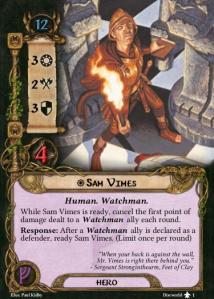
Sam Vimes was a difficult character to pin down to a sphere. Honestly I could easily see him in any sphere other than Lore, and even that’s not out of the question. But the breakdown of other characters I wanted as heroes left me wanting to have him in his role as commander of the Watch, being the leading hero for the trait. Which then left me needing to figure out what the defining feature of the Watchman trait should be. I figured it’d make sense if they focused somewhat on defending and preventing damage to characters – the Watch keeping everyone else safe. And then I hit on the quote in the flavour text and the abilities came together. They might be a bit on the powerful side which is why I restricted them to allies, so you potentially have a slightly slower start.
As far as his stats go, Vimes is portrayed as incredibly strong-willed, and he’s no slouch in combat either. I chose to put the emphasis more on defence than attack, but that I suppose I could see either way or even just 2 for both (I realised after finishing all the heroes that I’d made them generally pretty high on stats, but that’s partly because I picked mostly all the big players in the novels).
Rob Anybody
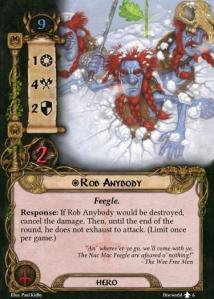
Rob is not perhaps my favourite of the three Tactics heroes I’ve done, but he is the one I’m happiest with the design of, while the other two need tweaking or possibly just changing. It’s also one of the more unusual abilities I came up with, though not the most unusual, we’ll get to that in a minute. Like all the Feegles, Rob Anybody is a massive combat threat in a very small package. Obviously more dangerous as an attacker, but I wanted to allow him the potential for a big defensive moment as well, so he could defend a boss enemy, trigger his ability, and then just go to town on all the enemies.
Esmerelda Weatherwax
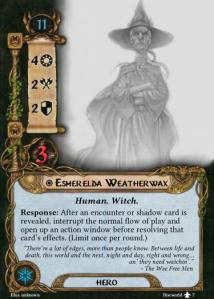
Almost certainly the weirdest ability I’ve come up with, and I’m still not sure how useful it’d be. With good planning you shouldn’t have too many moments where a certain card comes up and throws all your plans into disarray but you’d be able to fix it if you only had an action window… but there’s definitely a lot of scope there for interesting shenanigans so I went with it. If I change it, which I might, then Esme will probably end up with something along the lines I generally figured for the Witch trait – which is that since Discworld witches are a lot about balance, they probably have abilities that would allow you to redistribute negative effects rather than cancelling them outright, or to retarget them, or simply postpone them.
Tiffany Aching
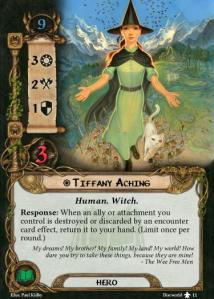
This was one I struggled with. Initially I thought I might actually have her interact with the Witch trait in general, which would’ve necessitated me actually designing some Witch allies to figure out what’d work… but then I started trying to think of alternatives based more on Tiffany’s individual qualities, and once again as soon as I thought of the relevant quote in the flavour text the ability just naturally presented itself. That treachery is discarding one of your attachments? Nope, back in your hand. Deal damage among characters you control? OK, assign a bunch of it to this one ally and return them to hand. Because these things are mine.
The Wizard trait
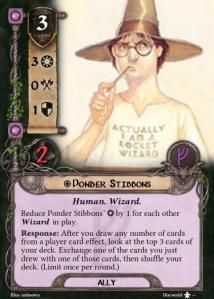
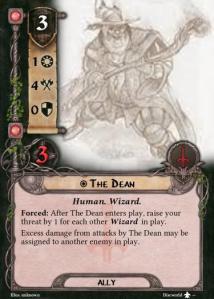
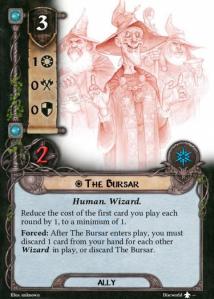
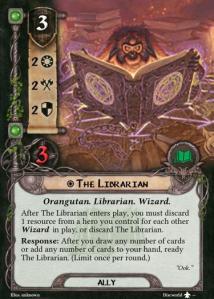
Obviously wizards are a big part of Discworld, somewhat more consistently present than they are in LotR. They’re also rather on the powerful side though, so balancing them seems a challenge. The idea I hit on very quickly was essentially the way they function in the books – in theory they’re very powerful, yes, but in practice they argue with each other too much. So I figured I’d give them all some reasonably potent effects, but then give them negative synergy with each other so you couldn’t play them all at once. Well, unless you had the good sense to bring along the Archchancellor as well to keep them more in line:
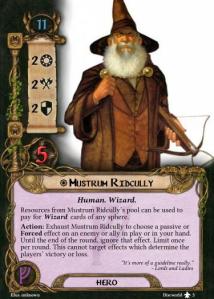
As soon as I hit on how I wanted the wizards to work I figured Ridcully would have to have an ability to somehow negate or at least mitigate the negative effects of putting them all together. Didn’t want it to be too easy though, thus the only ability I designed which requires exhausting the hero. To give it more widespread applications I also let it work on other allies and on enemies, though this is definitely another weird ability and one which required a bit of thought about how to close any loopholes into potentially broken territory (Don’t want you ignoring things like “The players cannot win while [enemy] is in play” or “If [objective ally] leaves play, the players have lost the game.”)
Leonard of Quirm
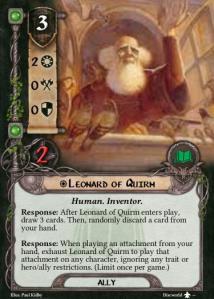
The infamous inventor was actually one of the first cards I came up with, before I’d even decided who all of my heroes were going to be. Card draw then discard seemed logical for Leonard’s tendency to have lots of ideas but then forget some of them. And then I liked the idea of the once per game ability representing Leonard’s ability to make things work which would usually be considered impossible. So he can give (almost) any attachment to any character who couldn’t usually have it.
Dwarf Bread
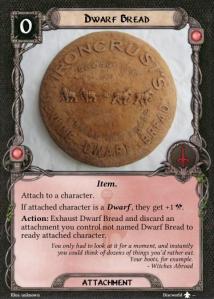
Dwarf bread gets fairly infamous, so naturally I had to find something to do with it. I considered just making it a Cram equivalent, but this version is more thematic for all that I’m not entirely sure how useful it’ll be.
We Can Rule You Wholesale
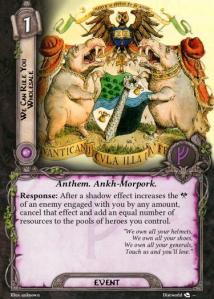
The good old Ankh-Morpork national anthem. Since the principle behind it (and indeed behind Ankh-Morpork’s mighty military presence as I recall) was that if anyone wanted to declare war on Ankh-Morpork they’d just call in all their debts, converting an attack boost into resources seemed exactly appropriate.
Million-to-one Chance
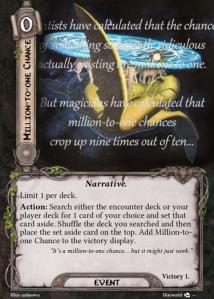
I could equally have named this ‘narrative causality’. Of course I was unsure about the idea of making this a player card since we know that trying to deliberately engineer a million-to-one chance yields less impressive results than when one naturally crops up, but it was such a good idea. I did at least make it limit once per deck, and I’m contemplating adding a caveat that effects which allow you to search any amount of your deck for a card and add something to your hand can’t take this card, so you have to just draw it randomly. In any case, the principle is obvious. There are always those moments when you realise you can only win if you reveal a specific card as your staging or draw a specific card off the top of your deck. This allows you to set those up.
Also, it is mandatory when playing this card to recite the flavour text.
Finally, we turn to the encounter deck. I figured actually quite a few of the books could be turned into one or more quests. But since I deliberately chose to time this post for the 25th of May, naturally I had to turn to Night Watch. And neatly as it turns out the plot of the book divides into a full 3 quest set (names potentially subject to change):
So we begin with Night Watch, in which you chase down Carcer over the rooftops of Unseen University, get flung back in time (which will split up the players) and have to take care of the Watch for the few days until everything really goes to hell.
Then we move onto The Glorious Twenty-Fifth of May, which covers building and defending the barricades, dealing with the Cable Street Particulars and the attack from Big Mary to last through the day until Winder is assassinated and replaced by Snapcase.
And we end with History Finds a Way, in which the revolution concludes, history reasserts itself in a dramatic confrontation, and we finally capture Carcer properly.
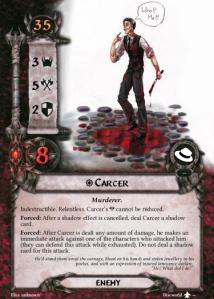
So for something which started as just some idle musings for my own amusement, this has come quite a way. At some point, I may even finish the set. Alternatively, as I said, this goes to show pretty clearly that the LotR rules can quite easily be applied to other things, so maybe instead I’ll come up with a custom set based on one of those. Maybe I’ll even use this design experience to make some actual LotR custom content, but I wouldn’t hold your breath for that last possibility. Regardless I hope that any Discworld fans among my readers at least derived some interest and enjoyment from this.

Some great cards here. I love the fact that the wizards don’t work well together and if you wanted to bring in these powerful characters you would have to work hard to accommodate them.
The cards look great too. Do you use Photoshop?
LikeLike
I use Strange Eons. It’s a program specifically for making cards and stuff and there are plugins for various specific games, including LotR.
LikeLike
I do like the thought put into these and agree that player card custom content is better when removed from the existing card pool into it’s own game. Love Granny Weatherwax!
LikeLike